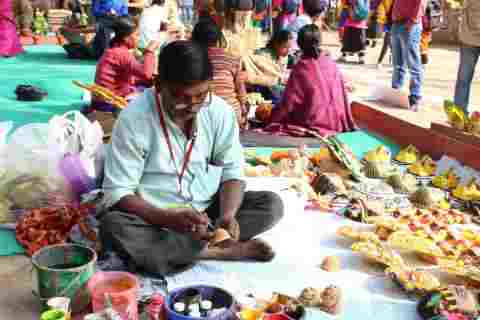
Pictutre shows Tribal artists displaying art and craft at Surajkund Mela in Harayana on February 9,2017.
For the first time,Jharkhand government has displayed tribal art-craft at the ongoing Surajkund Mela in Haryana.
While the tribal artists showed their ancient art and craft,the visitors got the opportunity to see the cultural mosaic of Jharkhand.In fact,this ‘mosaic’ was dreamt about,shaped and polised by generations of tribal communities who had inhabited this land since time immemorial.
Historical records revealed that archaeologists had unearthed pre-Harappan pottery, and pre-historic cave paintings and rockart indicating that India’s most ancient cultured civilizations inhabed these parts of India.
As it is,the arts and crafts form a significant part of the cultural lineage of Jharkhand. There are around 32 tribal groups including Santhals, Gonds, Birhors, Banjaras, Mundas and Asurs who have influenced the traditions of Jharkhand and imparted to it the richness and diversity that still exists there.
Most of the art forms are named after the tribes.Each tribe has its own unique form of expression and art. Some of the art forms are Paitkar, also called scroll paintings. They are considered to be one of the oldest tribal paintings in India where artisans from the Paitkar community use natural colour and vermillion to paint on soiled or used papers.
The Santhals practice the art of Jado or Jadopatia where the artisans make scrolls with natural inks and colours which are used as visual aids in storytelling and are said to have magical and healing powers. Meenu Anand along with her sister Shikha Anand from Durg has kept the art alive by painting the art on fabric. Surajkund Mela exhibits sarees, dupattas, etc made of silk with the beautiful Jado painting on it.
The Dhokra art is a metal craft or brass work done by the Malhore caste and the artisans make use of the ‘ lost wax technique’ by using resin, wax and firewood from the forests and clay from the riverbed and with the help of a firing oven in a hole dug in the ground they craft their artwork. Wonderful designs of Dhokra art have been exhibited in the Mela by the artists. Though the art is also popular in states like Orissa, Chattisgarh and West Bengal, the art practised in Jharkhand is more minute and fine.
Ganju art is drawn in large murals with images of plants, birds and animals and sometimes endangered animals are depicted in the pictures in story tradition form.
Other forms of art practised are the Sohrai art, Kohver art, Rana, Teli and Prajapati art, Kurmi art, Mundas art, Turi art, Birhor and Bhuiya art, Ghatwal art and the list goes on.
Jharkhand is aalso known for its wood work , Bamboo works, Tribal Ornaments and Stone Carving and many more. The beautifully carved wood products and bamboo products show the craftsmanship of the Jharkhand people.
Lack of promotion and marketing for these products has mostly resulted in extinction of some crafts like the stone carvings. The crafts of Jharkhand form a very significant part of the cultural lineage of the state of Jharkhand in India. The crafts at Jharkhand exhibit a great deal of expertise.
By exhibiting these ancient art and craft at the Surajkund Mela,the state government has sought to popularise it and make the tribal artists thrive.”We are proud to see them and their excellent art and craft”,said a visitor from Harayana.
